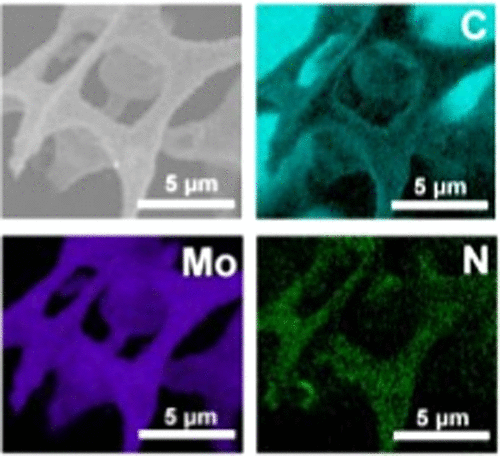当前位置:
X-MOL 学术
›
ACS Appl. Mater. Interfaces
›
论文详情
Our official English website, www.x-mol.net, welcomes your
feedback! (Note: you will need to create a separate account there.)
Interfacial Engineering of 3D Hollow Mo-Based Carbide/Nitride Nanostructures
ACS Applied Materials & Interfaces ( IF 8.3 ) Pub Date : 2021-10-12 , DOI: 10.1021/acsami.1c13289 Lifeng Wang 1 , Shenlong Zhao 2 , Yuchen Liu 1 , Dan Liu 1 , Joselito M Razal 1 , Weiwei Lei 1
ACS Applied Materials & Interfaces ( IF 8.3 ) Pub Date : 2021-10-12 , DOI: 10.1021/acsami.1c13289 Lifeng Wang 1 , Shenlong Zhao 2 , Yuchen Liu 1 , Dan Liu 1 , Joselito M Razal 1 , Weiwei Lei 1
Affiliation

|
Molybdenum carbide and nitride nanocrystals have been widely recognized as ideal electrocatalyst materials for water splitting. Furthermore, the interfacial engineering strategy can effectively tune their physical and chemical properties to improve performance. Herein, we produced N-doped molybdenum carbide nanosheets on carbonized melamine (N-doped Mo2C@CN) and 3D hollow Mo2C–Mo2N nanostructures (3D H–Mo2C–Mo2N) with tuneable interfacial properties via high-temperature treatment. X-ray photoelectron spectroscopy reveals that Mo2C and Mo2N nanocrystals in 3D hollow nanostructures are chemically bonded with each other and produce stable heterostructures. The 3D H–Mo2C–Mo2N nanostructures demonstrate lower onset potential and overpotential at a current density of 10 mV cm–2 than the N-doped Mo2C@CN nanostructure due to its higher active sites and improved interfacial charge transfer. The current work presents a strategy to tune metal carbide/nitride nanostructures and interfacial properties for the production of high-performance energy materials.
中文翻译:

3D 空心钼基碳化物/氮化物纳米结构的界面工程
碳化钼和氮化钼纳米晶已被广泛认为是理想的水分解电催化剂材料。此外,界面工程策略可以有效地调整它们的物理和化学性质以提高性能。在此,我们在碳化三聚氰胺(N 掺杂 Mo 2 C@CN)和 3D 空心 Mo 2 C–Mo 2 N 纳米结构(3D H–Mo 2 C–Mo 2 N)上制备了 N 掺杂碳化钼纳米片,具有可调界面特性通过高温处理。X 射线光电子能谱表明 Mo 2 C 和 Mo 23D 中空纳米结构中的 N 纳米晶体彼此化学键合并产生稳定的异质结构。与 N 掺杂的 Mo 2 C@CN 纳米结构相比,3D H-Mo 2 C-Mo 2 N 纳米结构在 10 mV cm –2的电流密度下表现出更低的起始电位和过电位,因为它具有更高的活性位点和改进的界面电荷转移. 目前的工作提出了一种调整金属碳化物/氮化物纳米结构和界面特性以生产高性能能源材料的策略。
更新日期:2021-10-27
中文翻译:

3D 空心钼基碳化物/氮化物纳米结构的界面工程
碳化钼和氮化钼纳米晶已被广泛认为是理想的水分解电催化剂材料。此外,界面工程策略可以有效地调整它们的物理和化学性质以提高性能。在此,我们在碳化三聚氰胺(N 掺杂 Mo 2 C@CN)和 3D 空心 Mo 2 C–Mo 2 N 纳米结构(3D H–Mo 2 C–Mo 2 N)上制备了 N 掺杂碳化钼纳米片,具有可调界面特性通过高温处理。X 射线光电子能谱表明 Mo 2 C 和 Mo 23D 中空纳米结构中的 N 纳米晶体彼此化学键合并产生稳定的异质结构。与 N 掺杂的 Mo 2 C@CN 纳米结构相比,3D H-Mo 2 C-Mo 2 N 纳米结构在 10 mV cm –2的电流密度下表现出更低的起始电位和过电位,因为它具有更高的活性位点和改进的界面电荷转移. 目前的工作提出了一种调整金属碳化物/氮化物纳米结构和界面特性以生产高性能能源材料的策略。











































 京公网安备 11010802027423号
京公网安备 11010802027423号